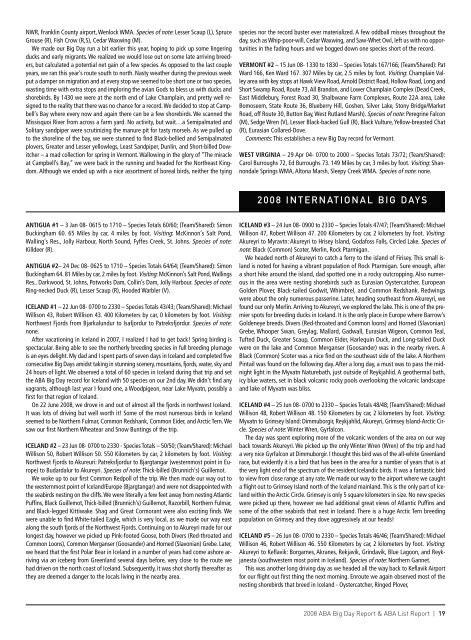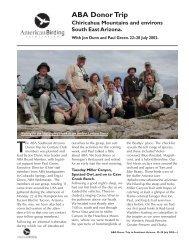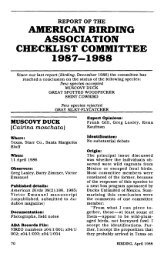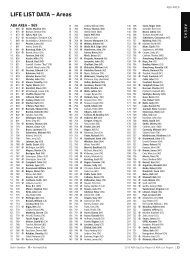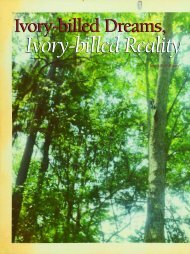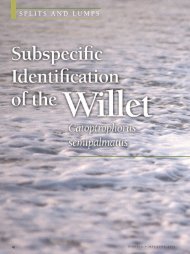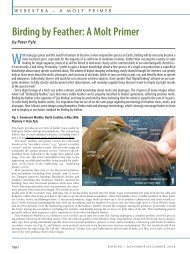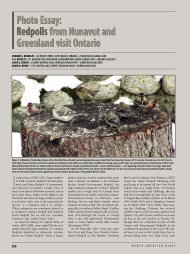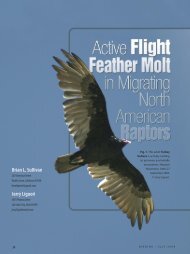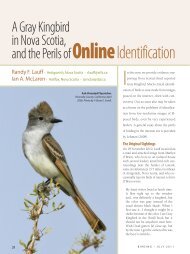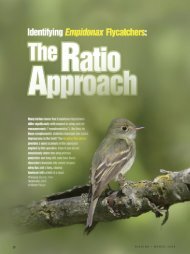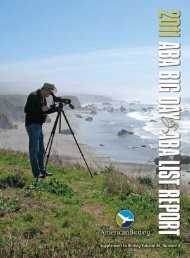Front End - American Birding Association
Front End - American Birding Association
Front End - American Birding Association
Create successful ePaper yourself
Turn your PDF publications into a flip-book with our unique Google optimized e-Paper software.
NWR, Franklin County airport, Wenlock WMA. Species of note: Lesser Scaup (L), Spruce<br />
Grouse (R), Fish Crow (R,S), Cedar Waxwing (M).<br />
We made our Big Day run a bit earlier this year, hoping to pick up some lingering<br />
ducks and early migrants. We realized we would lose out on some late arriving breeders,<br />
but calculated a potential net gain of a few species. As opposed to the last couple<br />
years, we ran this year’s route south to north. Nasty weather during the previous week<br />
put a damper on migration and at every stop we seemed to be short one or two species,<br />
wasting time with extra stops and imploring the avian Gods to bless us with ducks and<br />
shorebirds. By 1430 we were at the north end of Lake Champlain, and pretty well resigned<br />
to the reality that there was no chance for a record.We decided to stop at Campbell’s<br />
Bay where every now and again there can be a few shorebirds. We scanned the<br />
Missisquoi River from across a farm yard. No activity, but wait…a Semipalmated and<br />
Solitary sandpiper were scrutinizing the manure pit for tasty morsels. As we pulled up<br />
to the shoreline of the bay, we were stunned to find Black-bellied and Semipalmated<br />
plovers, Greater and Lesser yellowlegs, Least Sandpiper, Dunlin, and Short-billed Dowitcher<br />
– a mad collection for spring in Vermont. Wallowing in the glory of “The miracle<br />
at Campbell’s Bay,” we were back in the running and headed for the Northeast Kingdom.<br />
Although we ended up with a nice assortment of boreal birds, neither the tying<br />
species nor the record buster ever materialized. A few oddball misses throughout the<br />
day, such as Whip-poor-will, Cedar Waxwing, and Saw-Whet Owl, left us with no opportunities<br />
in the fading hours and we bogged down one species short of the record.<br />
VERMONT #2 – 15 Jun 08- 1330 to 1830 – Species Totals 167/166; (Team/Shared): Pat<br />
Ward 166, Ken Ward 167. 307 Miles by car, 2.5 miles by foot. Visiting: Champlain Valley<br />
area with key stops at Hawk View Road,Arnold District Road, Hollow Road, Long and<br />
Short Swamp Road, Route 73,All Brandon, and Lower Champlain Complex (Dead Creek,<br />
East Middlebury, Forest Road 30, Shalbwane Farm Complexes, Route 22A area, Lake<br />
Bomoseem, State Route 36, Blueberry Hill, Goshen, Silver Lake, Stony Bridge/Market<br />
Road, off Route 30, Button Bay,West Rutland Marsh). Species of note: Peregrine Falcon<br />
(M), Sedge Wren (V), Lesser Black-backed Gull (R), Black Vulture, Yellow-breasted Chat<br />
(R), Eurasian Collared-Dove.<br />
Comments: This establishes a new Big Day record for Vermont.<br />
WEST VIRGINIA – 29 Apr 04- 0700 to 2000 – Species Totals 73/72; (Team/Shared):<br />
Carol Burroughs 72, Ed Burroughs 73. 149 Miles by car, 3 miles by foot. Visiting: Shannondale<br />
Springs WMA, Altona Marsh, Sleepy Creek WMA. Species of note: none.<br />
2 0 0 8 I N T E R N AT I O N A L B I G D AY S<br />
ANTIGUA #1 – 3 Jan 08- 0615 to 1710 – Species Totals 60/60; (Team/Shared): Simon<br />
Buckingham 60. 65 Miles by car, 4 miles by foot. Visiting: McKinnon’s Salt Pond,<br />
Walling’s Res., Jolly Harbour, North Sound, Fyffes Creek, St. Johns. Species of note:<br />
Killdeer (R).<br />
ANTIGUA #2– 24 Dec 08- 0625 to 1710 – Species Totals 64/64; (Team/Shared): Simon<br />
Buckingham 64. 81 Miles by car, 2 miles by foot. Visiting: McKinnon’s Salt Pond,Wallings<br />
Res., Darkwood, St. Johns, Potworks Dam, Collin’s Dam, Jolly Harbour. Species of note:<br />
Ring-necked Duck (R), Lesser Scaup (R), Hooded Warbler (V).<br />
ICELAND #1 – 22 Jun 08- 0700 to 2330 – Species Totals 43/43; (Team/Shared): Michael<br />
Willison 43, Robert Willison 43. 400 Kilometers by car, 0 kilometers by foot. Visiting:<br />
Northwest Fjords from Bjarkalundur to Isafjordur to Patreksfjordur. Species of note:<br />
none.<br />
After vacationing in Iceland in 2007, I realized I had to get back! Spring birding is<br />
spectacular. Being able to see the northerly breeding species in full breeding plumage<br />
is an eyes delight. My dad and I spent parts of seven days in Iceland and completed five<br />
consecutive Big Days amidst taking in stunning scenery, mountains, fjords, water, sky and<br />
24 hours of light. We observed a total of 60 species in Iceland during that trip and set<br />
the ABA Big Day record for Iceland with 50 species on our 2nd day. We didn’t find any<br />
vagrants, although last year I found one, a Woodpigeon, near Lake Myvatn, possibly a<br />
first for that region of Iceland.<br />
On 22 June 2008, we drove in and out of almost all the fjords in northwest Iceland.<br />
It was lots of driving but well worth it! Some of the most numerous birds in Iceland<br />
seemed to be Northern Fulmar, Common Redshank, Common Eider, and Arctic Tern. We<br />
saw our first Northern Wheatear and Snow Buntings of the trip.<br />
ICELAND #2 – 23 Jun 08- 0700 to 2330 - Species Totals – 50/50; (Team/Shared): Michael<br />
Willison 50, Robert Willison 50. 550 Kilometers by car, 2 kilometers by foot. Visiting:<br />
Northwest Fjords to Akureuri: Patreksfjordur to Bjargtangar (westernmost point in Europe)<br />
to Budardalur to Akureyri. Species of note: Thick-billed (Brunnich’s) Guillemot.<br />
We woke up to our first Common Redpoll of the trip. We then made our way out to<br />
the westernmost point of Iceland/Europe (Bjargtangar) and were not disappointed with<br />
the seabirds nesting on the cliffs.We were literally a few feet away from nesting Atlantic<br />
Puffins, Black Guillemot,Thick-billed (Brunnich’s) Guillemot, Razorbill, Northern Fulmar,<br />
and Black-legged Kittiwake. Shag and Great Cormorant were also exciting finds. We<br />
were unable to find White-tailed Eagle, which is very local, as we made our way east<br />
along the south fjords of the Northwest Fjords. Continuing on to Akureyri made for our<br />
longest day, however we picked up Pink-footed Goose, both Divers (Red-throated and<br />
Common Loons), Common Merganser (Goosander) and Horned (Slavonian) Grebe. Later,<br />
we heard that the first Polar Bear in Iceland in a number of years had come ashore arriving<br />
via an iceberg from Greenland several days before, very close to the route we<br />
had driven on the north coast of Iceland. Subsequently, it was shot shortly thereafter as<br />
they are deemed a danger to the locals living in the nearby area.<br />
ICELAND #3 – 24 Jun 08- 0900 to 2330 – Species Totals 47/47; (Team/Shared): Michael<br />
Willison 47, Robert Willison 47. 200 Kilometers by car, 2 kilometers by foot. Visiting:<br />
Akureyri to Myravtn: Akureyri to Hrisey Island, Godafoss Falls, Circled Lake. Species of<br />
note: Black (Common) Scoter, Merlin, Rock Ptarmigan.<br />
We headed north of Akureyri to catch a ferry to the island of Firisey. This small island<br />
is noted for having a vibrant population of Rock Ptarmigan. Sure enough, after<br />
a short hike around the island, dad spotted one in a rocky outcropping. Also numerous<br />
in the area were nesting shorebirds such as Eurasian Oystercatcher, European<br />
Golden Plover, Black-tailed Godwit, Whimbrel, and Common Redshank. Redwings<br />
were about the only numerous passerine. Later, heading southeast from Akureyri, we<br />
found our only Merlin.Arriving to Akureyri, we explored the lake.This is one of the premier<br />
spots for breeding ducks in Iceland. It is the only place in Europe where Barrow’s<br />
Goldeneye breeds. Divers (Red-throated and Common loons) and Horned (Slavonian)<br />
Grebe, Whooper Swan, Greylag, Mallard, Gadwall, Eurasian Wigeon, Common Teal,<br />
Tufted Duck, Greater Scaup, Common Eider, Harlequin Duck, and Long-tailed Duck<br />
were on the lake and Common Merganser (Goosander) was in the nearby rivers. A<br />
Black (Common) Scoter was a nice find on the southeast side of the lake. A Northern<br />
Pintail was found on the following day. After a long day, a must was to pass the midnight<br />
light in the Myvatn Naturebath, just outside of Reykjahlid. A geothermal bath,<br />
icy blue waters, set in black volcanic rocky pools overlooking the volcanic landscape<br />
and lake of Myvatn was bliss.<br />
ICELAND #4 – 25 Jun 08- 0700 to 2330 – Species Totals 48/48; (Team/Shared): Michael<br />
Willison 48, Robert Willison 48. 150 Kilometers by car, 2 kilometers by foot. Visiting:<br />
Myvatn to Grimsey Island: Dimmuborgir, Reykjahlid,Akureyri, Grimsey Island-Arctic Circle.<br />
Species of note: Winter Wren, Gyrfalcon.<br />
The day was spent exploring more of the volcanic wonders of the area on our way<br />
back towards Akureyri. We picked up the only Winter Wren (Wren) of the trip and had<br />
a very nice Gyrfalcon at Dimmuborgir. I thought this bird was of the all-white Greenland<br />
race, but evidently it is a bird that has been in the area for a number of years that is at<br />
the very light end of the spectrum of the resident Icelandic birds. It was a fantastic bird<br />
to view from close range at any rate. We made our way to the airport where we caught<br />
a flight out to Grimsey Island north of the Iceland mainland. This is the only part of Iceland<br />
within the Arctic Circle. Grimsey is only 5 square kilometers in size. No new species<br />
were picked up there, however we had additional great views of Atlantic Puffins and<br />
some of the other seabirds that nest in Iceland. There is a huge Arctic Tern breeding<br />
population on Grimsey and they dove aggressively at our heads!<br />
ICELAND #5 – 26 Jun 08- 0700 to 2330 – Species Totals 46/46; (Team/Shared): Michael<br />
Willison 46, Robert Willison 46. 550 Kilometers by car, 2 kilometers by foot. Visiting:<br />
Akureyri to Keflavik: Borgarnes, Akranes, Rekjavik, Grindavik, Blue Lagoon, and Reykjanesta<br />
(southwestern most point in Iceland). Species of note: Northern Gannet.<br />
This was another long driving day as we headed all the way back to Keflavik Airport<br />
for our flight out first thing the next morning. Enroute we again observed most of the<br />
nesting shorebirds that breed in Iceland - Oystercatcher, Ringed Plover,<br />
2008 ABA Big Day Report & ABA List Report | 19


